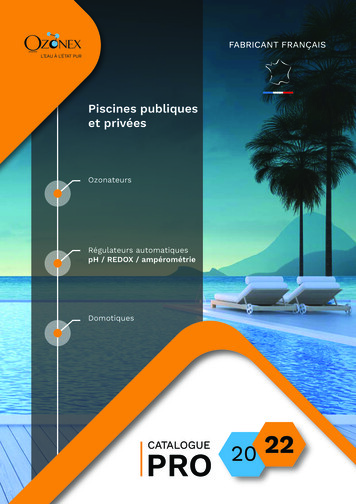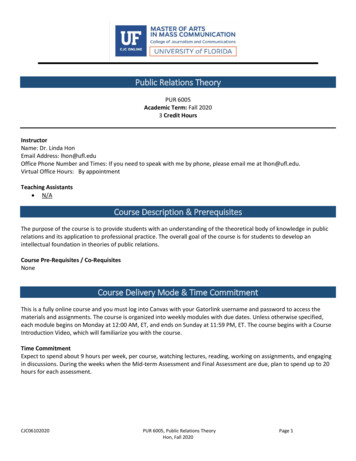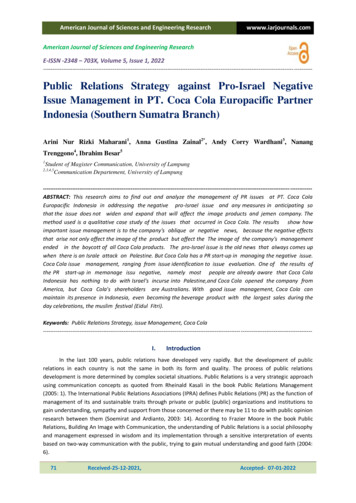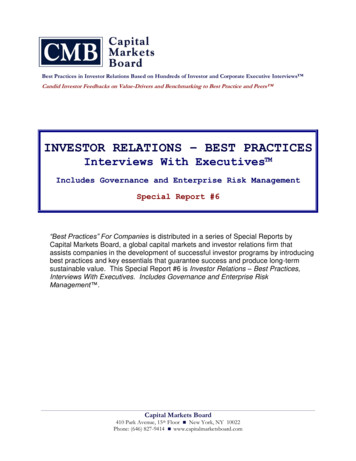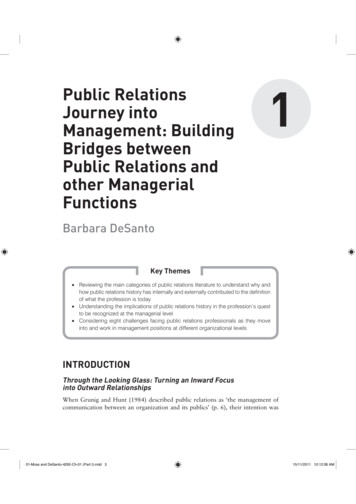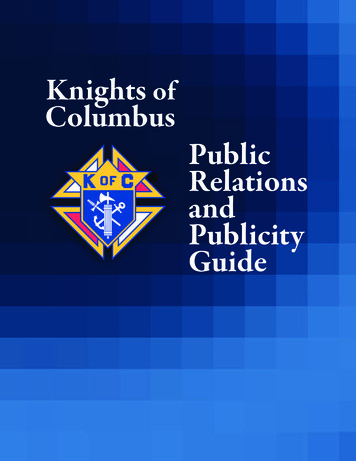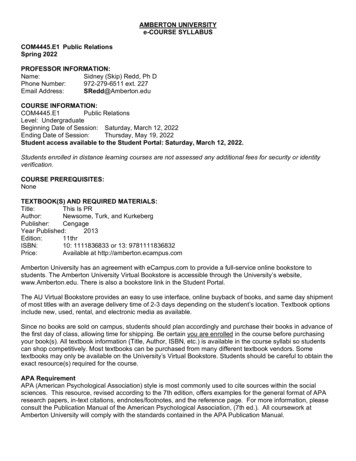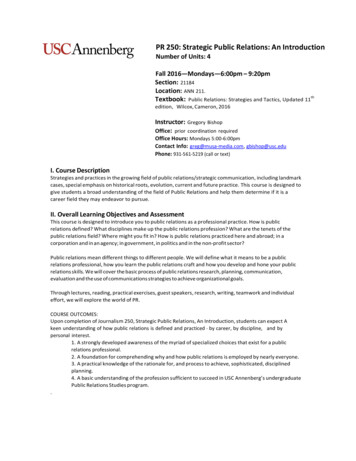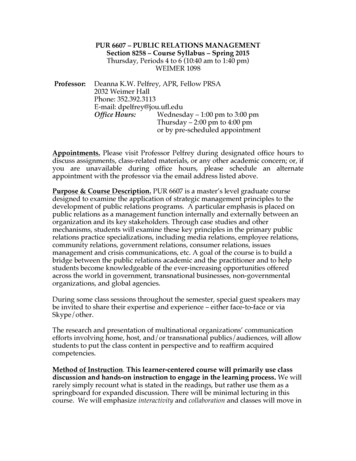
Transcription
PUR 6607 – PUBLIC RELATIONS MANAGEMENTSection 8258 – Course Syllabus – Spring 2015Thursday, Periods 4 to 6 (10:40 am to 1:40 pm)WEIMER 1098Professor:Deanna K.W. Pelfrey, APR, Fellow PRSA2032 Weimer HallPhone: 352.392.3113E-mail: dpelfrey@jou.ufl.eduOffice Hours:Wednesday – 1:00 pm to 3:00 pmThursday – 2:00 pm to 4:00 pmor by pre-scheduled appointmentAppointments. Please visit Professor Pelfrey during designated office hours todiscuss assignments, class-related materials, or any other academic concern; or, ifyou are unavailable during office hours, please schedule an alternateappointment with the professor via the email address listed above.Purpose & Course Description. PUR 6607 is a master’s level graduate coursedesigned to examine the application of strategic management principles to thedevelopment of public relations programs. A particular emphasis is placed onpublic relations as a management function internally and externally between anorganization and its key stakeholders. Through case studies and othermechanisms, students will examine these key principles in the primary publicrelations practice specializations, including media relations, employee relations,community relations, government relations, consumer relations, issuesmanagement and crisis communications, etc. A goal of the course is to build abridge between the public relations academic and the practitioner and to helpstudents become knowledgeable of the ever-increasing opportunities offeredacross the world in government, transnational businesses, non-governmentalorganizations, and global agencies.During some class sessions throughout the semester, special guest speakers maybe invited to share their expertise and experience – either face-to-face or viaSkype/other.The research and presentation of multinational organizations’ communicationefforts involving home, host, and/or transnational publics/audiences, will allowstudents to put the class content in perspective and to reaffirm acquiredcompetencies.Method of Instruction. This learner-centered course will primarily use classdiscussion and hands-on instruction to engage in the learning process. We willrarely simply recount what is stated in the readings, but rather use them as aspringboard for expanded discussion. There will be minimal lecturing in thiscourse. We will emphasize interactivity and collaboration and classes will move in
a seminar format much like the collaborations that operate in the professionalworld.This course is outcomes-based, and students will be evaluated primarily on theability to transfer the theory and knowledge shared in class and found inresearch into workable solutions. It is essential to keep up with the readingschedule and come to class with the assigned reading’s concepts in yourmemory and in your written reading notes. Not all of the materials that youread will be discussed or explained in class, therefore, if you need furtherexplanations or clarifications, please take advantage of the posted office hours.Course Objectives. Upon successful completion of this course, students who areactively involved in class – via participation, leading class discussions, postingcomments, research, reading, and other activities – should accomplish thefollowing objectives: To increase understanding of the major perspectives in publicrelations practice and management.To develop skills in applying public relations management principlesto a variety of organizational situations and circumstances.To apply knowledge of public relations management to the student’sown research and professional career.To increase awareness of the different types of private, public, forprofit, not-for-profit, and activist organizations that use publicrelations strategies in a global arena.To increase understanding of the issues of multiculturalism anddiversity related to public relations.Required Text. The required text for this course is:McKee, K.B., & Lamb, L. (2009). Applied Public Relations: Cases in StakeholderManagement (Second Edition). New York, New York: Routledge, Publisher.Because we have only one required text, significant supplemental readings willbe supplied or read online throughout the course.Recommended Supplemental Resources. General public relations web site portal, especially related to publicrelations education: http://lamar.colostate.edu/ pr/Institute for Public Relations: http://instituteforpr.org/Arthur W. Page Society resource links aspPublic Relations Society of America (PRSA): http://www.prsa.org/PRSA Silver Anvil Awards home page: http://www.silveranvil.orgPRSA Volunteer Chapter: http://www.volunteerprsa.org/Council of Public Relations Firms: http://www.prfirms.org/
Public Affairs Council: http://www.pac.org/Issues Management Council: http://www.issuemanagement.org/National Investor Relations Institute: http://www.niri.org/Global Alliance for Public Relations and Communication capes.aspInternational Association of Business Communicators:http://www.iabc.com/International Public Relations Association: http://www.ipra.org/Women Executives in Public Relations: http://www.wepr.org/National Black Public Relations Association: http://www.nbprs.org/Hispanic Public Relations Association: http://www.hpra-usa.org/Journal of Public Relations ct.cgi?sfxejournal 1062726XPublic Relations .cgi?sfxejournal 0363-8111Public Relations ect.cgi?sfxejournal 0033-3700Public Relations t.cgi?sfxejournal 1080-6792The Plank Center for Leadership in Public Relations:http://www.plankcenter.ua.edu/Additional Suggested Books and References.Maidment, Fred. (2009). Annual Edition: Management, 15/e. McGraw Hill.Morley, M. (2002). How to manage your global reputation: A guide to the dynamics ofinternational public relations. Washington Square, NY: New York UniversityPress.Moss, D. & DeSanto, B. (Eds.). (2002). Public relations cases: Internationalperspectives. New York: Routledge/Taylor & Francis Group.Newsom, D. (2007). Building the gaps in global communication. Malden, MA:Blackwell Publishing.Parkinson, M.G., & Ekachai, D. (Eds.). (2006). International and intercultural publicrelations: A campaign case approach (pp. 306-319). Boston, MA: PearsonEducation/Allyn & Bacon.Sriramesh, K. (2004). Public relations in Asia: An anthology. Singapore: ThomsonLearning Asia.Sriramesh, K., & Vercic, D. (Eds.). (2003). The global public relations handbook:theory, research, and practice. New Jersey: Lawrence Erlbaum Associates.Tilson, D.J., & Alozie, E.C. (2004). Toward the common good: Perspectives ininternational public relations. Boston, MA: Allyn and Bacon.The IABC Handbook of Organizational communication: A Guide to InternalCommuniccation, Public Relations, Marketing and Leadership (2006) – TamaraGillis, editor. ISBN-100787980803; ISBN-13: 978-0787980801.
Van Ruler, B., & Vercic, D. (2004). Public relations and communication managementin Europe: A nation-by-nation introduction to public relations theory and practice.Berlin, Germany: Mouton de Gruyter.Reading Assignments. While there is only one required text withdesignated/assigned readings, additional required readings will be assigned. Aspecific, topical reading schedule related to the text is provided to students onthe first day of class and posted to Sakai.Students may quickly fall behind and, therefore, are strongly advised to staycurrent with the reading assignments. Assigned readings should be completedprior to class; students should come to class with the assigned reading’sconcepts both in memory and in written reading notes, i.e., prepared to discussthem intelligently in class.Students should consider regularly reading the following publications in hardcopy or on-line: Public Relations Tactics (this publication may be distributed inclass as published); Communication World (available through IABC membership);PR Week (a weekly tabloid); The Economist; The Wall Street Journal; The New YorkTimes; The Washington Post; London Times; and Financial Times.Online Course Administration. Sakai will be used to administer the coursecommunication and materials (e.g., PowerPoint files, some additional readings,handouts, assignment guidelines, evaluation forms). You can access Sakai byusing your GatorLink username and password. Please check the site forannouncements and/or threads of comments from either course colleagues orthe professor.Course Professionalism. The College of Journalism and Communications is aprofessional school and professional decorum is expected at all times. Therefore,both the professor and students adhere to workplace norms for collegial andrespectful interaction. Students are expected to arrive on time, not leave earlyunless prior permission is granted and wait for the class to end before packingto leave.Further, students are expected to conduct themselves in an honest, ethical andcourteous manner – with classmates and with the professor. Eating andprivately chatting in class do not demonstrate professional behavior. Talkingwhile the instructor or another student is talking is unacceptable; such actionscan result in a lowering of your grade.Cell phones, pagers, beepers, BlackBerry devices, iPods, iPads, iPhones, SmartPhones, Androids, etc. must be turned off completely during class; silent modeor vibrate is not considered off. In the event of an emergency situation, notifythe professor at the start of class. Laptops may be used only as a note-takingdevice. Surfing the Internet, checking Facebook, creating email, playing gamesand other activities not related to class are strictly prohibited.
Diversity Statement. Effective public relations practice relies on the ability torecognize and embrace diversity in all its forms, including viewpoints.Throughout the class, students will have opportunities to see how different lifeexperiences and cultural perspectives influence public relations practice. You areencouraged to take advantage of these opportunities in your own work and tolearn from the information and ideas shared by other students. Every attempt ismade to make all courses non-sexist, diverse and multicultural in content.Should the course fail to meet this goal, please visit the professor to discuss.Students with Special Needs. Students requesting classroom accommodationmust first register with the Dean of Students Office. The Dean of Students Officewill provide documentation to the student who must submit a documentationletter to the professor when requesting accommodation. Please notify theprofessor at the beginning of the semester and schedule an appointment todeliver the accommodation letter and to discuss requests for special provisions.Academic Honesty. The work you submit must be your own work and it mustbe original for this class. You must not use direct or paraphrased material fromany other source, including web sites, without attribution. You cannot submitanything that a peer wrote for this class, you wrote for another class, at aninternship, as a volunteer, or in any other academic or professional setting. Theprofessor will handle any incident of academic dishonesty in accordance with theUniversity of Florida policy, such as the UF Honor Code and the AcademicHonesty Guidelines that have examples of cheating, plagiarism, bribery,misrepresentation, conspiracy and fabrication.Plagiarism (literary or artistic theft), copying someone else's work or other formsof dishonesty will not be tolerated. Any case of academic dishonesty will beconsidered grounds for an automatic failing grade in the course. Universityguidelines will be followed for any offenses.Having someone else do your work for you is considered academic dishonesty.When completing any of your writing assignments for this class, it is imperativeto clearly attribute where you obtained your information, whether it’s from aweb site or from an organization’s internal document. To clarify, you cannotcopy anything word for word from any source without putting quotes aroundit, even if it is provided directly to you from the organization. This includesweb site copy, mission statements, etc. In these cases, you should paraphrase andcite the source as you write or simply quote it.In short, please don’t try to cheat – it’s just too painful for both you and me!The University of Florida Honor Code was voted on and passed by the StudentBody in 2006. The specifics of the Honor Code are attached. estybrochure.html.)Attendance. As a graduate level course, attendance and punctuality areexpected. Anything else will negatively affect your grade. Attendance will be
taken every class. One absence will be allowed without penalty. More than oneabsence will result in a penalty of -1% on the final grade for each additionalabsence (maximum of 10%). Two unexcused late arrivals (or early departures)equal one absence.Please be seated and prepared for class to begin on time. Lectures anddiscussions will not be postponed to allow for unpacking. Students may pack toleave only when the professor has dismissed the class; premature packing isdisruptive to fellow students.Please be aware that a student who attends class irregularly, comes to classlate, leaves class early, fails to complete assignments on time or neglectsassigned readings or posting comments can normally expect to earn a lowgrade.Missed Class. Let the professor know in writing as soon as you realize you willneed to miss class, preferably at the beginning of the semester, as it allows criticalassignments or guest lectures to be properly planned.If you miss class for any legitimate reason, including sickness or universityrelated travel, you must contact the professor before class meets (email is fine)and, then, provide written documentation of the reason at the next classmeeting.Students missing class must obtain class notes from another student. Notesand/or PowerPoint slides are not available directly from the professor or thediscussion leader(s). PowerPoint slides will be posted on Sakai.Deadlines. The practice of public relations hinges on meeting deadlines. Missingdeadlines not only can damage a public relations professional’s credibility, butalso can lead to termination of a relationship with a client or to dismissal. Thus,deadlines are treated seriously in this class. All assignments are due by thestart of the class period on the date of the deadline, unless otherwise instructed.A student may submit a late assignment only if he or she adheres to thefollowing procedures:* notifies the professor on or before the due date* submits no more than one late assignment in a semester* submits the assignment within 4 days of the due date* accepts a grade penalty of 10% for each day the assignment is lateAny other late assignment will not be accepted and will be given a grade of zero.Format. All written work submitted for this course must be coherent, logical,and carefully edited. Writing proficiency is necessary to pass this course.Misspellings, syntax and grammar errors as well as other writing problems areunacceptable in work by public relations graduate students. Please do notsubmit materials with editing marks on them; all assignments must be “clientready.”
Unless otherwise specified, all written assignments must be typed with a 12point serif font (e.g., Times, Palatino, or Times New Roman), double-spacedand framed by one-inch margins. No additional consideration will be given towritten work accompanied by artwork or any other kind of design element.However, a well-designed piece for your portfolio will represent a tool to assistin a job search and is always appreciated.Mechanics & Fact Errors. Unless otherwise specified, use MLA or APA style onall assignments. Do not assume you will remember everything from earliercourses. Locate and open your stylebook now and review. The professor doesnot ask this to torture you, but because it is what is expected in the profession.Any paper containing a major factual error will receive a grade of 50. A majorfactual error is defined as one that gives the wrong information to the audience,including such things as misspelling the client’s name or the incorrectidentification of key sources. Errors which do a minor disservice to the reader,will be graded somewhat more leniently, but remember all factual errors will beconsidered serious.Course Requirements and Evaluation. The evaluation of coursework will bebased on the student’s knowledge and ability to apply the course materialand will be assessed in the following ways:(1) the ideas you conceive and the extent to which you consistently develop thoseideas,(2) the quality and added-value of your written assignments and in-class leddiscussions with particular focus on your research, insights to the challenges andopportunities, problem-solving capabilities, creative and original solutionsoffered, presentation skills and demonstrated professionalism,(3) the technical quality and content value of your individual comment andwritten assignments:- neat, error-free copy- material that is well-written, has clarity and is concise- pays special attention to spelling, grammar, punctuation and style- uses the correct basic format required for the assignment- professional, client-ready document presentation(4) the quality and extent of your in-class participation and understanding ofthe interrelationship between the assigned readings and the class discussions,and(5) performance on supplementary reading and research.
Assignments. Students will be evaluated on individual performancedemonstrated in six assignment areas, each of which constitutes a portion of thefinal grade. These assignments include the following:A. Discussion Leadership 25 percentOn most days, students will be scheduled to lead the class discussion for halfthe class period. Presentations should outline the key points of the readings(assume your class colleagues have read the assignment!) for that week and posequestions to the group to foster discussion. Be sure to highlight not only thetheoretical and conceptual implications of the readings, but also the practical andprofessional applications of the material as well.Additional literature on the topic beyond the assigned readings for that weekmust also be covered. The supplementary selections will need to be preapproved by the professor. In general, these should come from scholarly and/orprofessional sources, such as academic journals, books, conference papers, tradepublications, mass media, and so forth. When submitting these selections, pleaseinclude the entire citation in APA format. Once discussion leadershipassignments have been finalized, you will be required to immediately submityour proposed supplemental readings to the professor for approval.For all presentations, discussion leaders are expected to distribute an outline tothe class specifying what will be covered in the presentation. Activities,exercises, guest speakers, examples, and other creative approaches are welcomedand encouraged. Even when not serving as a leader, it is critical that you comeprepared and actively participate in the discussion. For the discussions to besuccessful, the entire class must read the cases each week.Assessment Criteria: Each discussion leader will receive two evaluations for thediscussion leadership assignment: oral and PowerPoint (or Prezi, Wix,Infographics, other). The professor will assign the discussion leadership gradebased on the assessment criteria posted on Sakai. Each discussion leader willcomplete a candid self-evaluation and will submit the completed form to theprofessor on the day of the presentation. Self- evaluation forms are posted onSakai.In class we will discuss and clarify the expectations for the discussion leadersand the schedule for discussion leadership; a detailed handout is provided.B. Comments: Option One or Two 10 percentOnline Comments. At a designated time in the semester, each student isexpected to post insightful and well-conceived comments to an on-linediscussion board on Sakai. Details regarding the individual postings aredescribed below and will be evaluated for the quality rather than the quantity ofthe post.
Students will have the choice of Option One OR Option Two as outlinedbelow and representing a value of 10%.OPTION ONEComment from a Public Relations/ Communications ManagementProfessional (10 percent) – Each student who selects Option One will decide,identify, search contact information, obtain professor’s approval, and, then,personally contact an international public relations professional engaged in apublic relations/communications management position in an agency/firm,corporation, not-for-profit or activist organization. In a concise and professionalmanner, discuss her/his professional experience in public relations management:challenges, rewarding experiences, etc. Post the comments from the selectedprofessional on the designated discussion board. Please provide the contactinformation for the person and document the date and time of the conferencecall/meeting. Prior to making contact, please submit in order of preference thenames, affiliations and titles of 3 selected professionals for approval by theprofessor; no student may contact a professional assigned to another studentfor this effort.OROPTION TWOComment from a Public Relations/Communications Author (10 percent) – Eachstudent who selects Option Two will decide, identify, search contactinformation, secure professor’s approval and, then, personally contact oneauthor either from the required text and other recommended books, or anyreference cited in the assigned chapters. Ask her/him a question regarding amain idea contained in her/his work that you found relevant or interesting. Postthe author’s comments in the designated discussion board. Please provide thecontact information for the author and document the date and time of theconference call/meeting. Prior to making contact, please submit in order ofpreference the names, affiliations and titles of 3 selected authors for approvalby the professor; no student may contact an author assigned to another studentfor this effort.NOTE: Whether you choose Option One or Option Two, you must submit arequest via email to Professor Pelfrey containing three names in order of yourpreference. Appropriate contact information must be provided. You may notsubmit the names of current members of the faculty at the UF College ofJournalism and Communications. The professor will consider your requestand will respond in a timely manner.C. Participation (attendance, discussion, etc.) 20 percentBecause this is a learner-centered course, student participation in classdiscussions and activities is essential. Individual assignments also contribute tothis portion of your grade. The quality of your participation in class discussions
and team presentations and assignments will affect your grade; therefore,attendance and active participation are crucial.The professor’s role in this course is one of collaborator, facilitator, and coach.The role of the professor and the students is to facilitate discussion. In otherwords, share thoughts, suggestions, criticisms, support, disagreement but,whatever you do, talk in class.Because of the discussion-style nature of the course, which can sometimesbecome passionate, please remember to be courteous in your exchanges withothers. Nonetheless, enthusiastic discourse is what frequently leads to thestrongest learning experiences.This portion of the grading is subjective, and you can earn full credit only if youconsistently contribute to the class. Keeping up with the required reading willmake contributions in this area more meaningful. Your participation effortsshould be steady throughout the course. At the end of the course, participationgrades primarily will be based on professor and peer assessments.D. Team Panel Project 25 percentStudents will be assigned to a team, which will form a “panel” to discuss aspecific current issue offered by the professor. Each team will give a presentationon the respective assigned topic in class during the final weeks of thesemester; a hard copy of the team presentation speaking notes will be requiredand submitted as well.Presentation: Each panel member is responsible for presenting key informationabout the topic and providing the class with some basic “dos and don’ts” and/orexamples of organizations that “do it well” and those who “do not do it so well.”Class readings can be used where appropriate, but additional research on thetopic is essential. Through this research, members of the team must determinewhat the professionals and experts say about how organizations and leadersshould deal with the topic; the panel members should explore current businessliterature to find examples of real organizations that are “doing it right” (howthey hire, train, access, integrate, and communicate with internal and externalaudiences related to this topic).Use of video, web materials and other multi-media is encouraged. Each teammust gather information from each panel member and create a 1-page (can befront and back) handout for all the students in the class to use as a guide tocurrent “best practices” on this topic. Each panel should take approximately 30minutes in duration with an additional 15 minutes at the end for team Q & A.Presentation/PowerPoint Speaking Notes: Team members must collaborate onwriting the speaking notes for the panel presentation. These speaking notesshould clearly explain the “best practices” related to the topic. A written hardcopy of the speaking notes is due to the professor in advance of the team panel
presentation. Also, these notes should be included in the final PowerPoints(Prezi, Wix, Infographics, other) submitted by 12:00 noon the day before the teampresentation.Assessment Criteria: Each student will receive two evaluations for the teamproject assignment: team and individual. The professor will assign the teamgrade based on the assessment criteria posted on Sakai. The individual grade willbe a result of evaluations by fellow teammates and the professor.Each team member will complete a peer evaluation for each team member aswell as a self-evaluation; the completed forms are due to the professor on the dayof the presentation. Peer evaluation forms are posted on Sakai.In class we will discuss and clarify the expectations for the team panelpresentations and the schedule for team panel presentations; a detailed handoutwill be provided on the first day of class.E. Management Analysis 20 percentThis paper is to be completed individually and to focus on a topic inmanagement that is of interest to you (pending the professor’s approval).Background: At some point in your career, you will assume a managerial role(either formally or informally) and be expected not only to make decisions thatrelate to your area of expertise in public relations, but also to serve the largerobjectives of the organization for which you work.The purpose of this paper is to allow you to complete a literature review andanalysis on the management topic of your choice in preparation for suchsituations. Your analysis should be written from the perspective of the publicrelations executive and must focus on a management topic.Topics: These topics are listed in the detailed handout for the ManagementAnalysis report paper.You may link your findings to an area or industry in which you might want towork, such as not-for-profit, international, corporate, political, healthcare, orother.To obtain final approval of your topic, please email the professor a summary ofyour proposed topic by the deadline specified in the reading schedule. Yoursummary should include the topic, purpose of the analysis, and examplereferences that will be used. And finally, see the professor with any questions.In class we will discuss and clarify the expectations and the schedule for themanagement analysis paper; a detailed handout is provided.Assessment Criteria: Each student will receive one evaluation for themanagement analysis assignment. The professor will assign a grade based on
the successful accomplishment of the assessment criteria posted on Sakai. Adetailed handout is provided.Course Grading.The grade for an assignment will depend partially on these components: A greatconceptual piece in the correct format with poorly edited writing will only geta maximum of a B, as will a technically excellent piece that is not wellconceptualized or in the correct format. If you are concerned about a gradereceived on a given assignment, please see the professor for discussion duringregular office hours.Assignment grades will be based on the following 100-point 0.0—75.966.0—69.960.0—65.9 59.9AB BC CD DEFinal grades for this course will be based on the total points earned over theterm. Letter grades will be based on the 100-point scale. Please note that plussesor minuses will NOT be used on final grades:90-10080-8970-7960-690-59ABCDEFor further information about grades and grading policy, please ies/regulationgrades.htmlAdditional Final NotesThe professor reserves the right to make changes if necessary to the gradingsystem, the syllabus and the schedule for this course.Computers are great tools, and we’ll obviously be using them in this course. Butthey can also be distracting! Laptop computers are welcome in class only fortaking notes. Because your classmates as well as the professor and guestlecturers will need your full attention during our brief class time together, youmay not eat, chat, email, text, tweet, surf, etc. during class time. If you simplymust engage in these a
PUR 6607 - PUBLIC RELATIONS MANAGEMENT Section 8258 - Course Syllabus - Spring 2015 Thursday, Periods 4 to 6 (10:40 am to 1:40 pm) WEIMER 1098 Professor: Deanna K.W. Pelfrey, APR, Fellow PRSA 2032 Weimer Hall Phone: 352.392.3113 E-mail: dpelfrey@jou.ufl.edu Office .
